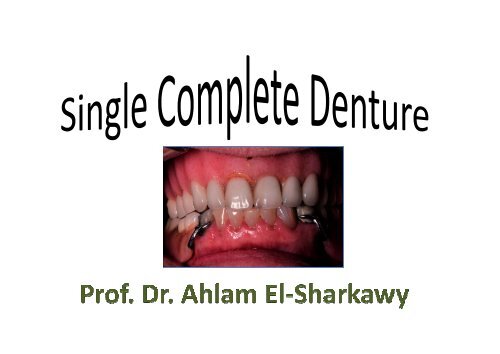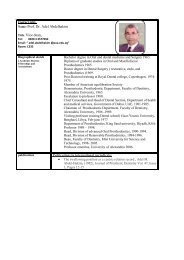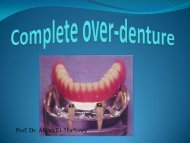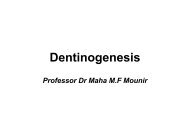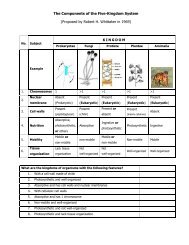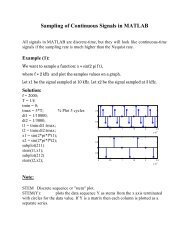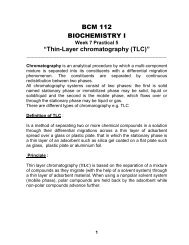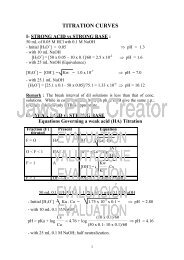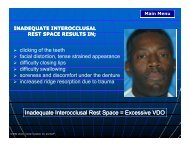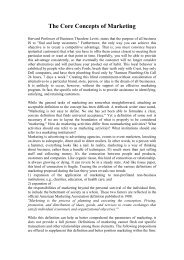1- Maxillary single denture opposing natural teeth
1- Maxillary single denture opposing natural teeth
1- Maxillary single denture opposing natural teeth
You also want an ePaper? Increase the reach of your titles
YUMPU automatically turns print PDFs into web optimized ePapers that Google loves.
Definition:<br />
• A <strong>single</strong> <strong>denture</strong> is a complete <strong>denture</strong> that<br />
occludes against some or all of the <strong>natural</strong><br />
<strong>teeth</strong>, a fixed restoration, or a previously<br />
constructed removable partial <strong>denture</strong> or a<br />
complete <strong>denture</strong>.
A <strong>single</strong> <strong>denture</strong> may oppose:<br />
1- Natural <strong>teeth</strong> that are sufficient in number<br />
not to necessitate a fixed or removable<br />
partial <strong>denture</strong>.<br />
1- <strong>Maxillary</strong> <strong>single</strong> <strong>denture</strong> <strong>opposing</strong> <strong>natural</strong><br />
<strong>teeth</strong>.
A <strong>single</strong> <strong>denture</strong> may oppose:<br />
2- A partially edentulous arch in which the<br />
missing <strong>teeth</strong> have been or will be replaced<br />
by a fixed partial <strong>denture</strong>.<br />
2- <strong>Maxillary</strong> <strong>single</strong> <strong>denture</strong> <strong>opposing</strong> fixed<br />
prosthesis
A <strong>single</strong> <strong>denture</strong> may oppose:<br />
3- A partially edentulous arch in which the<br />
missing <strong>teeth</strong> have been or will be replaced by<br />
a removable partial <strong>denture</strong>.<br />
3- <strong>Maxillary</strong> <strong>single</strong> <strong>denture</strong> <strong>opposing</strong> a<br />
partially edentulous arch and a RPD.
A <strong>single</strong> <strong>denture</strong> may oppose:<br />
4- An existing complete <strong>denture</strong>.<br />
4-<strong>Maxillary</strong> <strong>single</strong> <strong>denture</strong> <strong>opposing</strong> an existing<br />
complete <strong>denture</strong>
<strong>opposing</strong> <strong>natural</strong> <strong>teeth</strong>
Problems<br />
1- The <strong>natural</strong> <strong>teeth</strong> may be malposed or overerupted,<br />
the occlusal plane may be<br />
unfavorable.
Problems<br />
2- The fixed position of the mandibular anterior<br />
<strong>teeth</strong> may make esthetic and phonetic<br />
placement of artificial <strong>teeth</strong> difficult.
Problems<br />
3- Abrasion of acrylic <strong>teeth</strong> of the <strong>single</strong> <strong>denture</strong><br />
or abrasion of <strong>natural</strong> <strong>teeth</strong> if porcelain <strong>teeth</strong><br />
are used.
Problems<br />
4- Repeated midline fracture, due to:<br />
• Occlusal stress on maxillary <strong>denture</strong> and<br />
underlying edentulous tissues from <strong>opposing</strong><br />
<strong>natural</strong> dentition.<br />
• The position of mandibular <strong>teeth</strong>, which may<br />
not properly aligned for bilateral balance.<br />
• Flexure of <strong>denture</strong> bases.
• A cast metal base is recommended.
Cast Metal Denture Base<br />
• Use if <strong>denture</strong> fractures<br />
repeatedly<br />
• Usual causes:<br />
– Heavy forces from <strong>natural</strong> <strong>teeth</strong><br />
– Occlusal contacts on inclines<br />
– Impingement on a bony midline<br />
flexing of the <strong>denture</strong>
<strong>opposing</strong> fixed restoration
• The construction and placement of fixed<br />
restorations can correct many occlusal<br />
disharmonies.<br />
• Teeth in the <strong>single</strong> complete <strong>denture</strong> are on a<br />
movable base and they will function against<br />
the <strong>natural</strong> <strong>teeth</strong> as one unite.<br />
• The material of the artificial <strong>teeth</strong> should be<br />
considered.
<strong>opposing</strong> removable partial <strong>denture</strong>
• The partial <strong>denture</strong> must meet the<br />
requirements of an acceptable prosthesis, or it<br />
must be discarded.
The so-called combination syndrome<br />
(combination of complete and partial<br />
removable <strong>denture</strong>s)
<strong>Maxillary</strong> complete <strong>denture</strong> <strong>opposing</strong><br />
kennedy’s class I situation and include:
Combination syndrome<br />
1) Extrusion of the lower anterior <strong>teeth</strong> and occlusal plane<br />
discrepancy.
Combination syndrome<br />
2) Loss of bone from the maxillary anterior edentulous ridge
Combination syndrome<br />
3) Down growth of maxillary tubersities.
Combination syndrome<br />
4) Palatal papillary hyperplasia.
4-Tissue reaction to wearing a<br />
previous prosthesis<br />
• Palatal papillary hyperplasia
Combination syndrome<br />
5) loss of bone beneath the removable partial <strong>denture</strong>.
4-Tissue reaction to wearing a<br />
previous prosthesis<br />
• Epulis fissuratum
Combination syndrome<br />
Clinical factors encouraging development of<br />
this syndrome:<br />
1. Patient with angle class III.<br />
2. Patient whose mandibular posterior <strong>teeth</strong><br />
have not been replaced for extended period<br />
of time.<br />
3. Patient with parafunctional habits.
• The normal(class I )and the prognathic(class<br />
III) jaw relationships unfavorable dislodging<br />
forces are invited.
Prevention<br />
• Retain weak posterior <strong>teeth</strong> or roots as<br />
abutments by means of endodontic and<br />
periodontic techniques.
Prevention<br />
• Using endosseous implants.
Treatment<br />
• Anterior overerupted <strong>teeth</strong>… shortening,<br />
crowning
Treatment<br />
• The design should be rigid and provide<br />
maximum stability and retention.
Treatment<br />
• Anterior <strong>teeth</strong> should be used for cosmetic<br />
and phonetic purpose only.<br />
• Posterior <strong>teeth</strong> should be in balancing<br />
occlusion.
Treatment<br />
• Frequent reline of the RPD to stabiblize<br />
occlusion.<br />
• Cantiliver bridge can be used using canine and<br />
first premolar as abutments.<br />
• Endosseous implant may be placed in the<br />
edentulous posterior region.
<strong>opposing</strong> an existing complete <strong>denture</strong>
• It is much wiser and simpler to construct both<br />
complete upper and lower <strong>denture</strong>s as a<br />
unite.<br />
• The occlusal plane should approximately<br />
• The occlusal plane should approximately<br />
bisect the intermaxillary space.
Generally contraindicated
Why is contraindicated?<br />
• The force of jaw closure with <strong>natural</strong> <strong>teeth</strong> is<br />
greater than that with complete<br />
<strong>denture</strong>…..bone resorption.<br />
• The mandible is the movable member of the<br />
stomatognathic system…….difficutl<br />
stabilization.<br />
• The proximity of the mandibular <strong>denture</strong> with<br />
the tongue……….. great instability.<br />
• A smaller basal seat ………..more stress per<br />
unite area will be applied.
Indication<br />
• For patients with class III jaw relationship.<br />
• In cases of congenital or aquired palatal<br />
defects.<br />
• Mental trauma.<br />
• Health factors.


